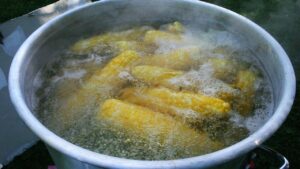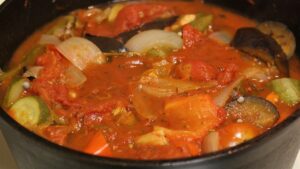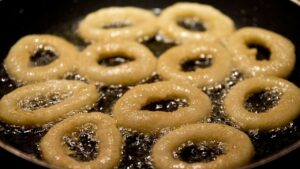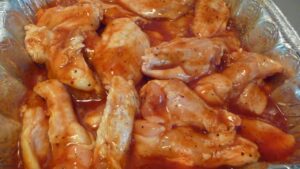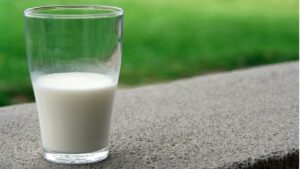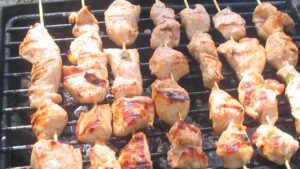What is Blanching?
Blanching is a cooking process that involves briefly scalding a food item, typically a vegetable or fruit, in boiling water, then quickly removing it and submerging it in ice water or running it under cold water to stop the cooking process.
The purpose of blanching is to inactivate enzymes, alter texture, remove peels, and wilt tissue. This technique is commonly used as a pre-treatment method in the food industry and in home kitchens for freezing, drying, or canning vegetables and fruits.
Blanching times are usually measured in seconds, and the usual duration is between 30 and 60 seconds. After blanching, the food item is often shocked by being submerged in ice water to halt any cooking that has already begun.
Key Takeaways
- Food is briefly submerged in a hot liquid, such as boiling water or oil, during the blanching process.
- This technique is frequently used as a prelude to further cooking food, but it is not always necessary.
- The foods that are blanched the most frequently are fruits, vegetables, and nuts.
- Blanching is a pre-treatment method used in home kitchens and the food industry.
- Its primary function is to inactivate the enzymes that result in browning and textural changes.
- Blanching stops air from expanding while being processed, which lessens the pressure on the containers and the possibility of cans having faulty seams.
- Boiling water is the most effective way to process vegetables for home freezing.
- It should take the same amount of time to cool vegetables as to blanch them.
Understanding Blanching
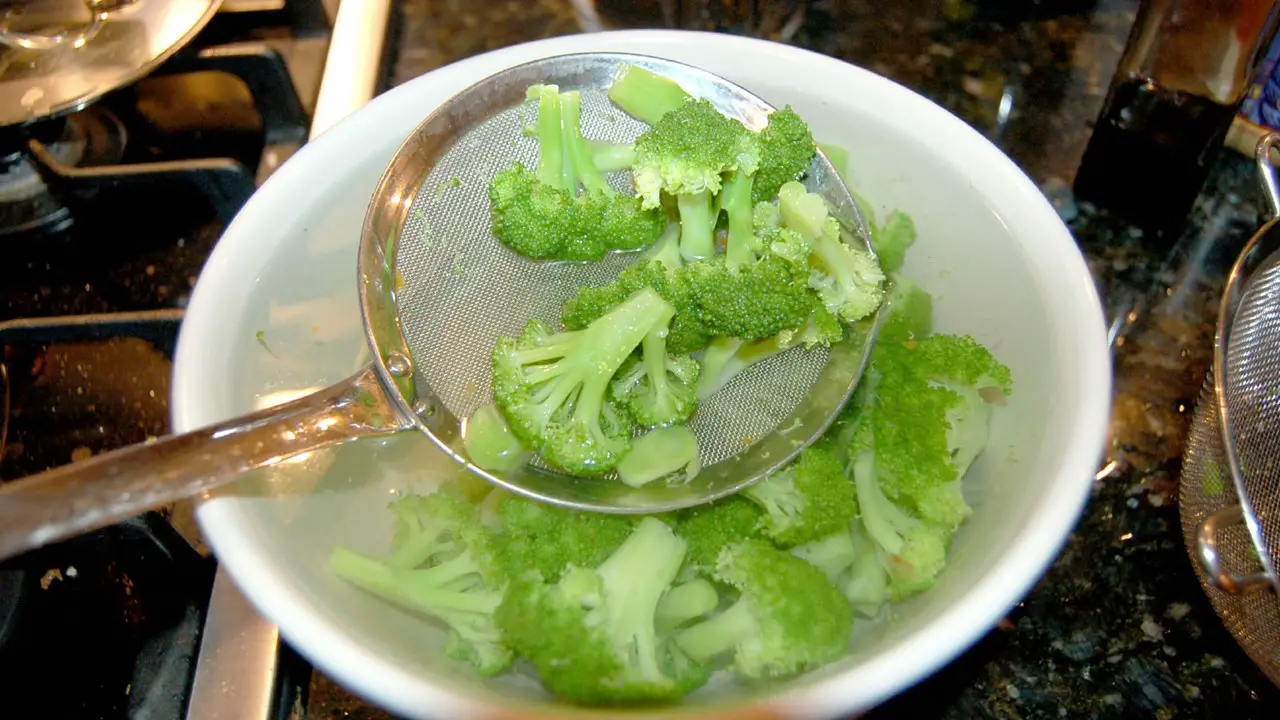
The origin of Blanching goes to boiling where the vegetables and eggs are blanched with a semi-boiling method.
You can say the dishes are semi-boiled which means it undergoes boiling for a minimal period.
That means when the vegetables are blanched they get a bright color and get the best of their nutrients almost intact.
It is a part that involves whitening the fruits and vegetables. For the semi-cooked dishes as per the requirements of the chef, the process of blanched is being used.
Food is briefly submerged in a hot liquid, such as boiling water or oil, during the blanching process.
This technique is frequently used as a prelude to further cooking food, but it is not always necessary.
The foods that are blanched the most frequently are fruits, vegetables, and nuts, each for a different purpose.
Sometimes it might be to soften it, to loosen the skin to make peeling it easier, or simply to brighten its color.
In the above description, take note of the word briefly. Blanching times are measured in seconds rather than minutes because different recipes will call for different blanching times.
Between 30 and 60 seconds is the usual blanching duration.
Blanching is frequently followed by a second process called shocking, which involves dropping the blanched food item immediately into an ice water bath to halt any cooking that has already begun.
This is a sign that blanching is more of a prepping technique than a cooking technique. Food should not be cooked during a blanching process.
Cooking, if necessary, will take place after the food is prepared. Otherwise, food that has been blanched is still regarded as raw.
The secret to shocking is to not let the food sit in the ice water for an extended period because it will start to soak up water and get soggy.
Instead, you want to simply chill the food until it is no longer warm, then thoroughly drain it and either store it or set it aside for the subsequent action.
While it doesn’t have to be completely cold throughout, it shouldn’t feel warm to the touch either.
Importance of Blanching
Commercial Food Industry
Both in the home kitchen and the food industry, blanching is a pre-treatment method.
In both instances, its primary function is to inactivate the enzymes that result in browning and textural changes.
The enzymes lipoxygenase, polyphenol oxidase, polygalacturonase, and chlorophyllase are responsible for the deterioration of fruits and vegetables.
Due to their high thermal resistance, catalase and peroxidase are frequently used to assess the success of blanching.
These enzymes are in charge of the flavor, color, texture, and nutritional value loss that occurs when a product is stored.
Canning
Before canning, the process of blanching releases trapped air from plant tissues.
Blanching stops air from expanding while being processed, which lessens the pressure on the containers and the possibility of cans having faulty seams.
In addition, removing gas from foods like pears improves the texture and lessens product oxidation.
Additionally, the intercellular gases are no longer present, which improves color retention.
Almonds and Nuts
Peeling fruits, vegetables, and nuts is essential for food processing.
By blanching nuts like almonds or pistachios, the skin—which is, botanically speaking, the seed coat that surrounds the embryo—softens and can be removed with ease later.
In comparison to chemical or manual peeling processes, steam peeling causes less environmental pollution and peeling losses.
Safe and Nutritional
Blanching can also be used to improve drying rates and product quality, lower microbial loads, remove toxic and pesticide residues, extract more bioactive compounds, remove damaged seeds or foreign objects, kill parasites and their eggs, and decrease oil uptake.
Rids the Vegetable’s Surface of Debris and Organisms
Blanching your vegetables will give them a more thorough cleaning if you believe that washing them under running water is insufficient to get rid of the stubborn dirt and unwanted creatures that may be hiding inside.
Before being stored, the boiling water is hot enough to burn off dirt and kill insects.
Preserves Vitamin Content While Enhancing Natural Color
Making vegetables taste and look better is an excellent additional benefit of blanching before storing.
This is because blanching preserves the color, and flavor, and even stops further loss of the natural nutrients that can occur during long-term storage.
Convenient Storage
Your vegetables will taste better after blanching, and it will be simpler to store them as well.
Since you have cut the vegetables into more uniform sizes, they are already simpler to store, but the brief immersion in boiling water may cause the vegetables to wilt or even soften just enough to facilitate storage.
Types of Blanching
Water Blanching
Boiling water is the most effective way to blanch all vegetables for home freezing.
Use a blancher with a blanching basket and cover or insert a wire basket into a large pot with a lid.
Per pound of cooked vegetables, use one gallon of water. The vegetable should be placed in a blanching basket and lowered into a pot of rapidly boiling water.
Put a lid on the blancher. You are using too many vegetables for boiling water if the water doesn’t return to boiling in one minute.
Start timing the blanching process once the water reaches a boil once more. Keep the heat on high for the duration specified in the instructions for the vegetable you are processing.
Steam Blanching
For a few vegetables, steam heating is advised. Steaming and boiling work well for vegetables like broccoli, pumpkin, sweet potatoes, and winter squash.
Use a pot with a secure lid for steaming, and a basket to hold the food so that it is at least three inches above the pot’s bottom.
Put about an inch or two of water in the pot, and then bring the water to a boil.
Place the vegetables in the basket in a single layer to ensure that the steam quickly reaches every area.
Heat should be kept at a high level while the pot is covered. Once the lid is on, begin timing the steaming process.
Blanching in the Microwave
Research suggests that some enzymes may not be inactivated by microwave blanching.
Off-flavors, as well as a loss of texture and color, may result from this.
Anyone choosing to microwave-blanch vegetables at the risk of poor quality should make sure to work in small batches and follow the instructions for their microwave oven.
Time or energy cannot be saved by blanching in the microwave.
Tips to Make Blanching Better
Be Ready: An ice bath, a sizable bowl of ice water, a slotted spoon, and a plate covered in cloth or paper towels should all be at the ready. Bring a sizable pot of water to a boil over high heat.
Prepare the vegetables in the meantime. By doing this right before blanching, oxidation is avoided. To guarantee even cooking, cut them into uniform pieces.
Salt: Add a few tablespoons of salt to the boiling water right before you start to blanch the vegetables. Salt enhances flavor and aids in color preservation, but it is optional.
Boiling Water: To keep the water from boiling over, add the vegetables to the pot in small batches.
If you are blanching multiple types of vegetables, do so one at a time and start with the lighter-colored ones. Darker-colored vegetables will taint the water and subsequent vegetables.
Doneness: Check for doneness after around 30 seconds. Take one piece out, dunk it in the ice water bowl, and taste.
Taste the vegetables every 30 to 60 seconds until they are done to your liking. Most vegetables require two to five minutes.
Slotted Spoon: With a slotted spoon, quickly remove the cooked vegetables from the boiling water and drop them into the ice bath to stop the cooking.
Remove the vegetables from the ice bath once they have completely cooled, and then place them on the plate that has been lined with towels to drain.
Cooling: To stop the cooking process after blanching, the vegetables must be thoroughly and quickly cooled.
The vegetable basket should be dropped into a sizable container of water that is 60°F or colder right away to cool.
Use ice water or replace the water often. Cold running water is an additional option.
If ice is used, it will take about a pound of ice for every pound of vegetables. Vegetables should be cooled down for the same amount of time as they are blanched.
Uses of Blanching in Indian Cuisine
In Indian cuisine, blanching is a common technique used for various purposes. Here are some of the ways blanching is used in Indian cuisine:
Removing the skin of nuts: Many Indian dishes use nuts like almonds, pistachios, and cashews.
Blanching these nuts in hot water for a few minutes makes it easier to remove their skin, which is often bitter. The blanched nuts can then be used in various dishes like desserts, curries, and biryanis.
Preparing vegetables for curries: Blanching vegetables like cauliflower, broccoli, green beans, carrots, and potatoes for a few minutes before adding them to a curry helps to soften them and preserve their color. This also helps to reduce the cooking time required to prepare the dish.
Preparing tomatoes for sauces: To prepare tomato-based sauces like marinara or tomato puree, blanching tomatoes in hot water for a few minutes makes it easier to remove the skin and puree them. This method also helps to preserve the bright red color of the tomatoes.
Preparing leafy vegetables for salads: Blanching leafy greens like spinach in hot water for a few seconds helps to wilt them slightly, which makes them easier to handle and more digestible. This method also helps to remove any impurities from the leaves.
Preparing ingredients for pickling: Blanching lemon in hot water before pickling helps to soften them and preserve their texture. This also helps to remove any impurities and bacteria from the surface of the fruit.
Finally, blanching is a versatile cooking technique that is widely used in Indian cuisine. It helps to improve the texture, flavor, and appearance of various ingredients used in dishes.
Whether you are making a curry, sauce, salad, or pickles, blanching can be a useful tool in your culinary arsenal.
Conclusion
Blanching is also used when making white stocks like chicken or veal stocks, where the bones are blanched first to remove impurities.
Another effective method for keeping avocados from turning brown is blanching.

